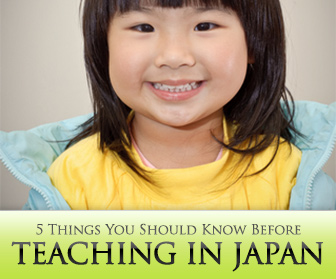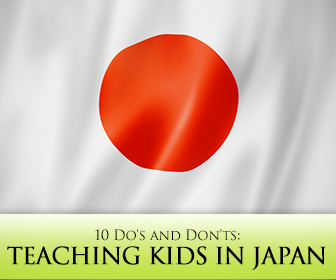5 Things You Should Know Before Teaching in Japan



When conversation runs dry, or you just want to get a reaction, busting out photos from your home country, or small things like money, can get them excited. Don’t just show pictures of your city – show your family, or what a typical American/British home looks like on the inside. Think of specific things that don’t exist – or are very different - in Japan to spark conversation. Just don’t do this all the time, as they might lose interest.
When your mutual vocabulary is limited, it’s natural – and encouraged – to use gestures to communicate. Using thumbs-up to indicate “yes” or “good” is fine, and our usual instinct is to reverse it – a thumbs-down – to indicate “no” or “bad”. A friend of mine did this with a class of small children, and they burst out crying. The reason: in Japan, this gesture can be very offensive (something like “go to hell”). Instead, cross your arms in front of you to make an “X”.
It might seem a little nerdy, but sneaking popular cartoon characters – both Japanese (like Pikachu) and well-know international (like Mickey Mouse) – into your games and worksheets can liven up a tired class. Smaller kids will go crazy over a picture of Hello Kitty, and even the older, moody kids will manage a little smile (even if it’s because they think you’re a dork). For grammar-related worksheets, you can add a character with a speech bubble, demonstrating the target language for the lesson. Students also warm to you when you share some of their interests, so showing that you’re familiar with whatever they’re into is a good way to win them over.
I discovered early on that Japanese people don’t like to give direct opinions – they prefer to dance around the topic, using “I’m not exactly sure yet…” when they mean “no”. A lot of ESL activities involve getting kids to give an opinion, but take those role-plays and debates into your average Japanese classroom and you’ll be met with an awkward silence. Nobody wants to upset the status-quo by saying something outlandish. Add to that the general shyness of students as they get older (and terrified of making mistakes) and you’ll spend a lot of time trying to get an answer. While louder students might offer you their opinion, remember that this is not a culture where individualism is encouraged.
After years of being told that English is hard and generally being discouraged by teachers who don’t really know how to teach a second language, many students are hesitant when it comes to even the simplest “My name is…” On top of that, students who are great at English will often hide their talents for fear of being ridiculed. You’ll often have to repeat things over and over, and even then some students won’t get it – or will pretend not to, to remain part of the group. Be very patient, praise small steps and don’t get angry if they make mistakes.
A classic go-to game to fill in time, and one that many new teachers think is a great idea. It might seem overly “PC” but due to Japan’s high suicide rate (and a story where a suicide victim’s mother blamed the ALT for playing Hangman with the class), it’s generally a good idea to avoid this game. Think about it; it’s a pretty disturbing game, anyway. There are plenty of alternatives you can play, such as drawing one feature on a scary monster for every wrong answer, or erasing part of a picture (such as petals on a flower).
Although your students will be curious about where you come from, many kids have very little knowledge of other countries and a lot of pride in their own. If you disagree with the way the Japanese do something, it’s best to keep it to yourself. This even goes for things that seem trivial – they won’t expect you to like some of their food (like “natto”), but complaining about things in general - food, weather, squat toilets – won’t win you any popularity. Kids will be amused to see you “fitting in”, talking about how much you love sushi and Arashi, and will be glad that you enjoy their culture.
Another seemingly small thing. When marking work, we would usually use an “X” for an incorrect answer, and a tick/check for a correct one. However, the “tick” in Japan also denotes an incorrect answer. Imagine how demoralised those clever kids could feel when you hand back their work, covered in checks! The way to show a correct answer is to draw a circle around it or next to it.
No matter how listless your class of teenagers seem, your job is to be bubbly, confident, and enthusiastic – what they call “genki”. Not only could you put your job in jeopardy by appearing bored, tired, or lazy, but you will sap the energy of those who do want to learn and make them feel as if English is a chore. Younger kids will love your enthusiasm and feed off it. You don’t have to act like a party clown, but smile and be approachable. At the end of my first year of teaching, a shy student wrote me a letter, thanking me for always being kind and friendly. You never know how much your actions can affect those kids, so be nice.
Back home, a student who fell asleep in class would get a good telling-off from the teacher, so when your students start to snooze during your riveting grammar explanations, it’s natural that you feel annoyed and want to wake them. I was tempted the first time it happened, but the Japanese teachers told me that it was normal. Many students stay in school until dinner time, eat something, and go straight to juku (“after-school”) to study some more. Add homework and exam cramming, and you’ll start to see why those older kids are so exhausted. Let the poor things sleep, and enjoy your time with the rest. However, if everyone falls asleep, it’s probably time to look at what you’re doing in class!